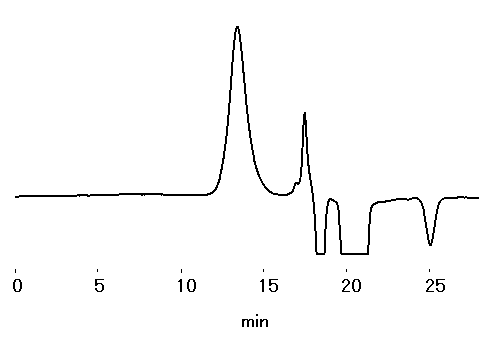Linear Type Column: LF-804
| LF | · Employs a special packing materials with a wide pore size distribution (multi pore type) · Enables analysis over a broad range of molecular weights (100 to2 million) · Highly linear calibration curve without infection points · Molecular weight distribution can be determined with high precision · Column for rapid analysis (LF-604) and columns for high performance analysis (LF-404) enabling reduction in solvent use are also available |
Please refer to Replacement of In-Column Solvent
*Use of the LF-604 and the LF-404 with semi-micro type devices is recommended.
(Standard column) shipping solvent : Tetrahydrofulan (THF)
| Product code | Product name | Plate number (TPN/column) |
Exclusion limit
(Polystyrene) |
Particle size (micron) |
Size(mm) ID x Length |
|---|---|---|---|---|---|
|
GPC LF-804
GPC LF-G |
> 17,000
Guard column |
2,000,000
– |
6
6 |
8.0 x 300 4.6 x 10 |
|
Product
name |
Max. usable pressure(MPa) |
Recommended
flow rate(mL/min) |
Max. usable flow rate(mL/min) |
Max. usable temp. (deg-C) |
|---|---|---|---|---|
|
LF-804
LF-G |
3.5
– |
1.0
– |
2.0
– |
20 to 60 20 to 60 |
(Rapid analysis downsized column) shipping solvent : Tetrahydrofulan (THF)
| Product code | Product name | Plate number (TPN/column) |
Exclusion limit
(Polystyrene) |
Particle size (micron) |
Size(mm) ID x Length |
|---|---|---|---|---|---|
|
GPC LF-604
GPC LF-G |
> 9,000
Guard column |
2,000,000
– |
6
6 |
6.0 x 150 4.6 x 10 |
|
Product
name |
Max. usable pressure(MPa) |
Recommended
flow rate(mL/min) |
Max. usable flow rate(mL/min) |
Max. usable temp. (deg-C) |
|---|---|---|---|---|
|
LF-604
LF-G |
3.5
– |
0.5
– |
1.0
– |
20 to 60 20 to 60 |
(High-perfomance semi-micro column) shipping solvent : Tetrahydrofulan (THF)
| Product code | Product name | Plate number (TPN/column) |
Exclusion limit
(Polystyrene) |
Particle size (micron) |
Size(mm) ID x Length |
|---|---|---|---|---|---|
|
GPC LF-404
GPC LF-G |
> 14,000
Guard column |
2,000,000
– |
6
6 |
4.0 x 250 4.6 x 10 |
|
Product
name |
Max. usable pressure(MPa) |
Recommended
flow rate(mL/min) |
Max. usable flow rate(mL/min) |
Max. usable temp. (deg-C) |
|---|---|---|---|---|
|
LF-404
LF-G |
3.5
– |
0.3
– |
0.6
– |
20 to 60 20 to 60 |
1. Features of LF-804
When three grades of organic SEC (GPC) columns, each of which has a different exclusion limit were used in series, an unnatural bump was apparently generated on the chromatogram. While using so-called mixed-bed columns packed with several grades of particles in optimum proportions, the shape of the peak has improved to some extent. However to check the chromatogram in detail, a slight shoulder is observed. It seems due to the fact that a linear calibration curve cannot be obtained only by mixing different types of particles. On the contrary, by using GPC LF-804 column, a very natural-shaped peak with no bumps or distortion was obtained. This column is manufactured by packing with a single grade of particles, each of which has a broad pore size distribution. Consequently, its calibration curve is very linear over a molecular range from 300 to 2,000,000. That is why no unnatural distortion is generated on the chromatogram.(Fig.1)
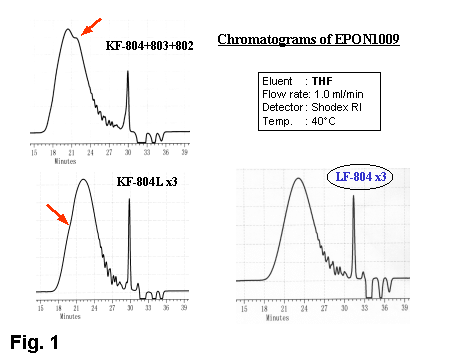
2. Chromatograms of Phenol resin
When analyzing a phenol resin, a more remarkable difference was observed. Based on such chromatograms having big distortions, it is difficult to gain a accurate calibration curve. Using a broad pore size distribution column like the LF-804, we can easily prevent the generation of bumps and distortions . (Fig.2)
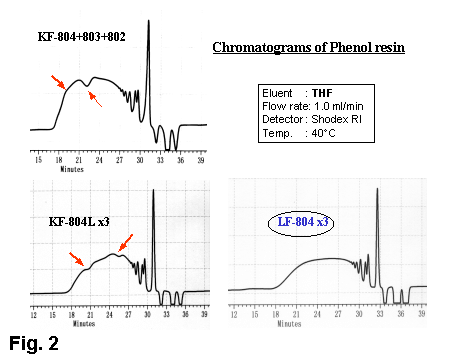
3. Separation conditions of Phenol resin (1) ; DMF and 10mM LiBr in DMF
For phenol resins, an abnormal shape of chromatogram occurs in DMF without the addition of salt. Only after the addition of 10mM LiBr does the accurate measurement of the molecular weight distribution become possible. (Fig.3)
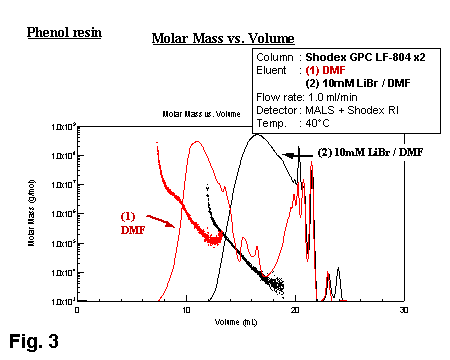
4. Separation conditions of Phenol resin (2) ; THF and 10mM LiBr in DMF
The chromatogram in THF was superimposed upon that in DMF added 10mM LiBr. By comparison, the peaktop in THF is shifting backward. Consequently, it is assumed that the molecular size of the phenol resin in THF is a little smaller, because it elutes a little later than in LiBr-added DMF. (Fig.4)
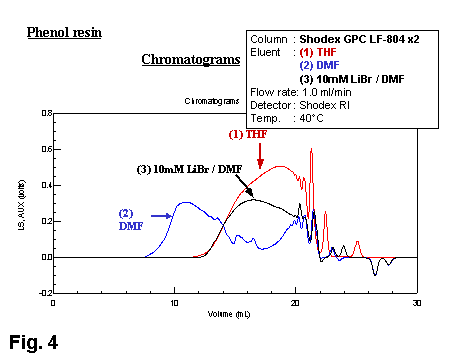
5. Separation conditions of melamine resin (EPON 1009)
The chromatograms, analyzed with THF, DMF or 10mM LiBr in DMF, were superimposed . In the every case, a natural peak with very good symmetry was obtained. Moreover, the eluting positions were almost same. From these results, we can conclude that the size of one molecule of EPON 1009 in DMF is almost same as that in THF. (Fig.5)
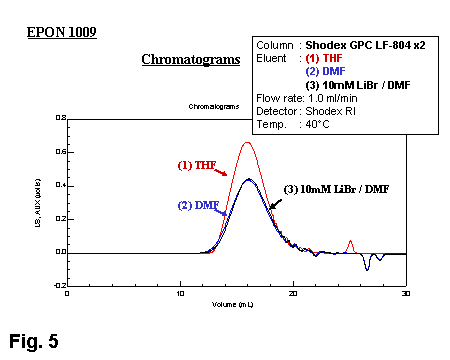
6. Size expansion of EPON 1009 in DMF
Since the LF-804 column can be used with different solvents, we attempted to analyze the same samples using DMF as the eluent. Looking at the chromatogram derived from the RI detector, we see that normal peaks were obtained even without the addition of LiBr. However, the molecular weight plots obtained by MALS are more widely distributed in DMF compared with the case in LiBr-added DMF. The difference suggests that a size expansion of the molecules is taking place to some extent. (Fig.6)
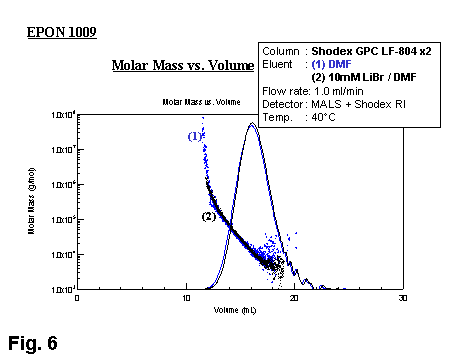
Please refer to the following tables for the classification of solvents in terms of capability of being replaced with original in-column solvent. However, frequent replacement of in-column solvent may shorten column life, and is, therefore, not recommended. We can replace the in-column solvent with another solvent such as o-dichlorobenzene, ethyl acetate, dimethylacetamide or methylpyrrolidon upon your request.
(Standard Organic SEC (GPC) columns)

(Downsized GPC columns and Semi-micro GPC columns)
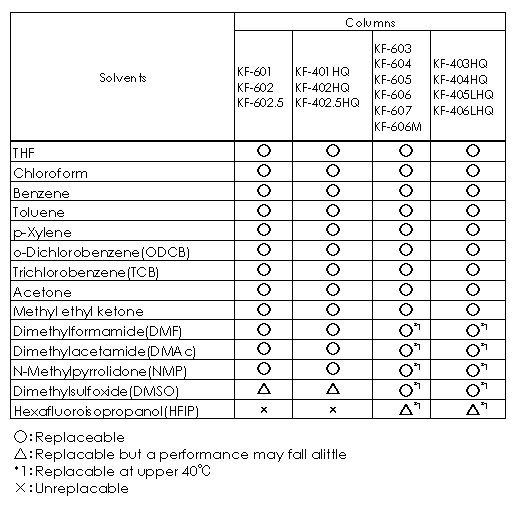
(Linear Type : LF series)
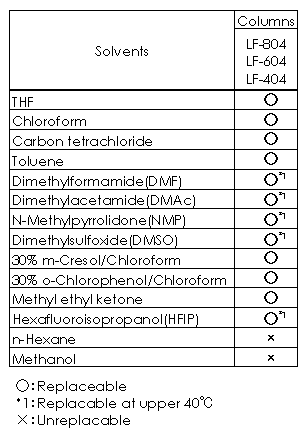
Calibration curves for GPC LF-804 is shown. The good linear line can be obtained in the range of molecular weights 300-2,000,000.
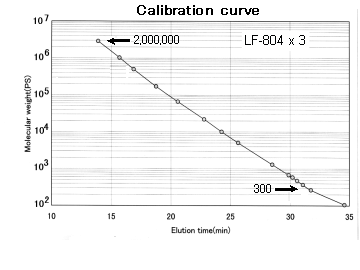
Sample : PS, Polystyrene
Columns : Shodex GPC LF-804 (8.0mmID*300mm) x 3 Eluent : THF Flow rate : 1.0mL/min Detector : Shodex RI Column temp. : 40deg-C
The calibration curve of PEG/PEO standards using organic SEC (GPC) column LF-804 with DMAc as an eluent is shown.
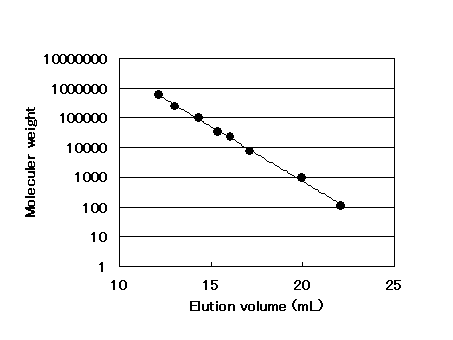
Sample : 200micro-L
PEO, Poly(ethylene oxide)
PEG, Poly(ethylene glycol)
Columns : Shodex GPC LF-804 (8.0mmID*300mm) x 2 Eluent : 30mM LiBr in DMAc Flow rate : 0.7mL/min Detector : Shodex RI Column temp. : 40deg-C
The calibration curve of polystyrene standards using organic SEC (GPC) column GPC LF-804 with DMAc as an eluent is shown.
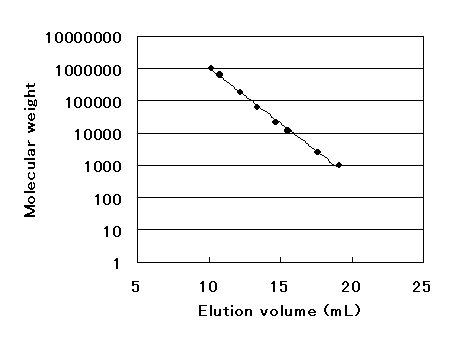
Sample : 200micro-L
PS, Polystyrene
Columns : Shodex GPC LF-804 (8.0mmID*300mm) x 2 Eluent : 30mM LiBr in DMAc Flow rate : 0.7mL/min Detector : Shodex RI Column temp. : 40deg-C
Poly(methyl methacrylate) (PMMA) standards were analyzed using organic SEC (GPC) column GPC LF-804.
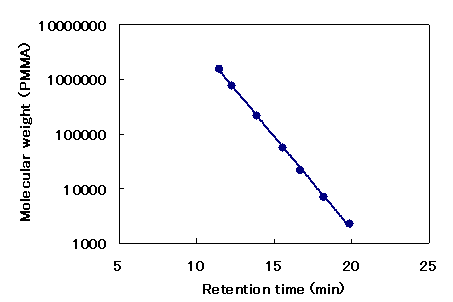
Sample : Poly(methyl methacrylate) (PMMA)
100micro-L
(MW: 1,520,000) 0.05%
(MW: 772,000) 0.1%
(MW: 211,000) 0.1%
(MW:55,900) 0.1%
(MW:21,700) 0.1%
(MW:6,900) 0.1%
(MW:2,220) 0.1%
Columns : Shodex GPC LF-804 (8.0mmID*300mm) x 2 Eluent : Methyl ethyl ketone Flow rate : 1.0mL/min Detector : Shodex RI Column temp. : 40deg-C
Polystyrene standards were analyzed using organic SEC (GPC) column GPC LF-804 with DMAc as an eluent.
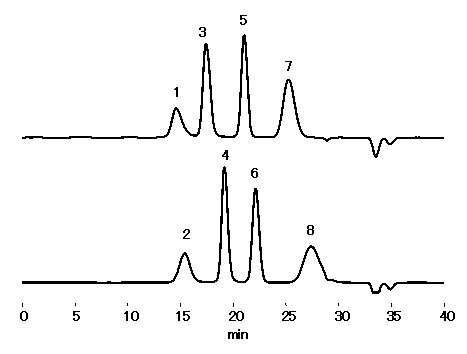
Sample : 200micro-L
1. PS, Polystyrene (MW: 1,010,000) 0.05%
2. PS, Polystyrene (MW: 630,000) 0.1%
3. PS, Polystyrene (MW: 186,000) 0.05%
4. PS, Polystyrene (MW: 65,500) 0.1%
5. PS, Polystyrene (MW: 22,000) 0.05%
6. PS, Polystyrene (MW: 11,600) 0.1%
7. PS, Polystyrene (MW: 2,450) 0.05%
8. PS, Polystyrene (MW: 980) 0.1%
Columns : Shodex GPC LF-804 (8.0mmID*300mm) x 2 Eluent : 30mM LiBr in DMAc Flow rate : 0.7mL/min Detector : Shodex RI Column temp. : 40deg-C
Phenoxy Resin was analyzed using GPC LF-804 (a column for organic SEC (GPC)).

Sample : 0.2% Phenoxy resin, 50micro-L
Columns : Shodex GPC LF-804 (8.0mmID*300mm) x 3 Eluent : THF Flow rate : 1.0mL/min Detector : Shodex RI Column temp. : 40deg-C
Polycarbonate resin resin was analyzed using GPC LF-804 (a column for organic SEC (GPC)).
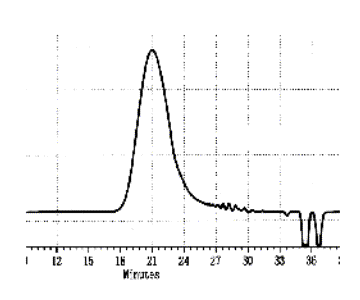
Sample : 0.2% Polycarbonate resin, 50micro-L
Columns : Shodex GPC LF-804 (8.0mmID*300mm) x 3 Eluent : THF Flow rate : 1.0mL/min Detector : Shodex RI Column temp. : 40deg-C
Poly(vinyl butyral) resin was analyzed using GPC LF-804 (a column for organic SEC (GPC)).
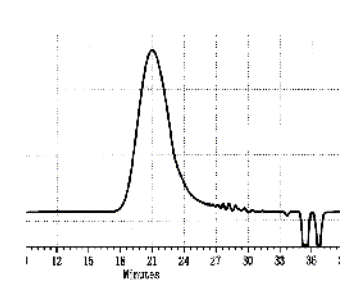
Sample : 0.2% Poly(vinyl butyral), 50micro-L
Columns : Shodex GPC LF-804 (8.0mmID*300mm) x 3 Eluent : THF Flow rate : 1.0mL/min Detector : Shodex RI Column temp. : 40deg-C
Poly(vinyl formal) resin was analyzed using GPC LF-804 (a column for organic SEC (GPC)).
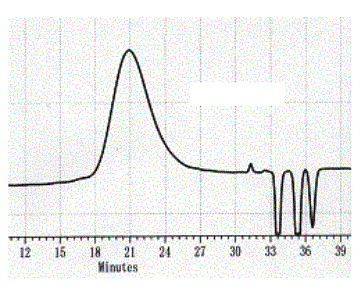
Sample : 0.2% Poly(vinyl formal), 50micro-L
Columns : Shodex GPC LF-804 (8.0mmID*300mm) x 3 Eluent : THF Flow rate : 1.0mL/min Detector : Shodex RI Column temp. : 40deg-C
Poly(4-vinylpyridine) was analyzed using GPC LF-804 (a column for organic SEC (GPC)). With addition of 10mM LiBr to DMF, adsorption of a basic sample to gel is suppressed.
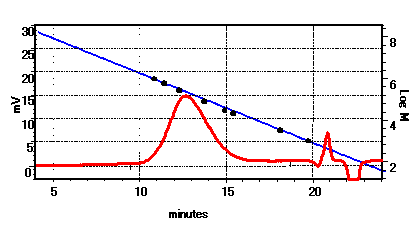
Sample : 0.1% Poly(4-vinylpyridine), 100micro-L
Columns : Shodex GPC LF-804 (8.0mmID*300mm) x 2 Eluent : 10mM LiBr in DMF Flow rate : 1.0mL/min Detector : Shodex RI Colomn temp. : 40deg-C
Poly(2-vinylpyridine-co-styrene) was analyzed using GPC LF-804 (a column for organic SEC (GPC)). With addition of 10mM LiBr to DMF, adsorption of a basic sample to gel is suppressed. The calibration curve was made with Poly(ethylene oxide), which showed high linearity even in DMF system.

Sample : 0.1% Poly(2-vinylpyridine-co-styrene), 100micro-L
Columns : Shodex GPC LF-804 (8.0mmID*300mm) x 2 Eluent : 10mM LiBr in DMF Flow rate : 1.0mL/min Detector : Shodex RI Colomn temp. : 40deg-C
Polystyrene standards are separated with Shodex organic SEC (GPC) columns. GPC LF-804 column whose exclusion limit is 2million can separate low molecular weight sample and polystyrene oligomer are also separated well at the same time.
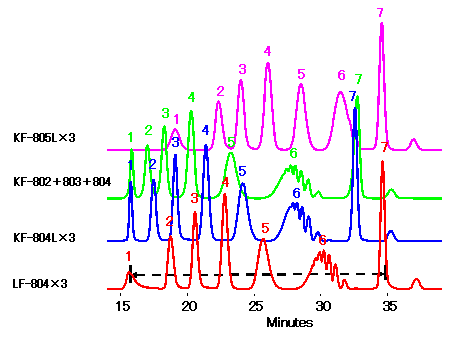
Sample :
1. PS, Polystyrene (MW: 1,030,000)
2. PS, Polystyrene (MW: 171,000)
3. PS, Polystyrene (MW: 66,000)
4. PS, Polystyrene (MW: 22,000)
5. PS, Polystyrene (MW: 15,050)
6. PS, Polystyrene (MW: 580)
7. Ethylbenzene
Columns : Shodex GPC LF-804 (8.0mmID*300mm) x 3
Shodex GPC KF-804L (8.0mmID*300mm) x 3
Shodex GPC LF-805L (8.0mmID*300mm) x 3
Shodex GPC KF-804 + KF-803 + KF-802 (8.0mmID*300mm each)
Eluent : THF
Flow rate : 1.0mL/min
Detector : Shodex RI
Column temp. : 40deg-C
Polystylene standards were analyzed by organic solvent SEC (GPC), GPC LF-804, using DMAc as an eluent.
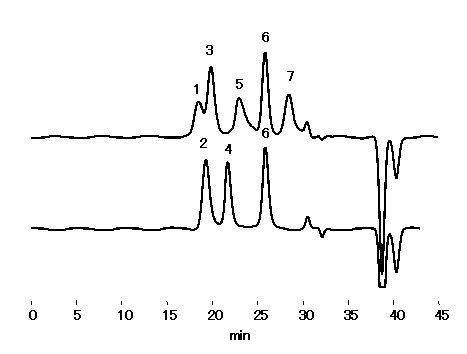
Sample : 0.1% each, 200micro-L
1. PEO, Poly(ethylene oxide) (MW: 276,300)
2. PEO, Poly(ethylene oxide) (MW: 167,700)
3. PEO, Poly(ethylene oxide) (MW: 126,500)
4. PEO, Poly(ethylene oxide) (MW: 43,520)
5. PEG, Poly(ethylene glycol) (MW: 22,800)
6. PEO, Poly(ethylene glycol) (MW: 4,020)
7. PEO, Poly(ethylene glycol) (MW: 1,080)
Columns : Shodex GPC LF-804 (8.0mmID*300mm) x 2 Eluent : 30mM LiBr in DMAc Flow rate : 0.7mL/min Detector : Shodex RI Column temp. : 40deg-C
Poly(methyl methacrylate) was analyzed using GPC LF-804 (a column for organic SEC (GPC))
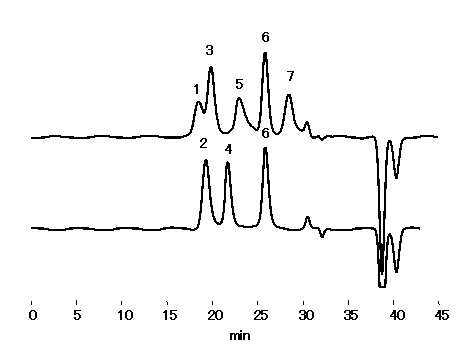
Sample : 100micro-L
Poly(methyl methacrylate) (PMMA)
Columns : Shodex GPC LF-804 (8.0mmID*300mm) x 2 Eluent : Methyl ethyl ketone Flow rate : 1.0mL/min Detector : Shodex RI Column temp. : 40deg-C
Comparison of chromatograms of GPC LF-404, LF-604 and LF-804 are shown. LF-404 shows as same as LF-804. LF-604 gives rapid separation.
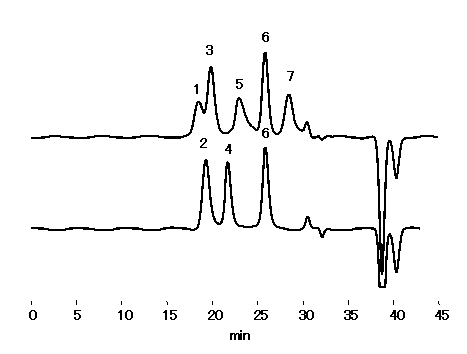
Sample : PS, Polystyrene
Columns : Shodex GPC LF-804 (8.0mmID*300mm) x 2
Shodex GPC LF-404 (4.6mmID*250mm) x 2
Shodex GPC LF-604 (6.0mmID*150mm) x 2
Eluent : THF
Flow rate : (LF-804); 1.0mL/min, (LF-404); 0.3mL/min, (LF-604); 0.6mL/min
Detector : Shodex RI (LF-804; conventional, LF-404,604; small cell volume)
Column temp. : 40deg-C


